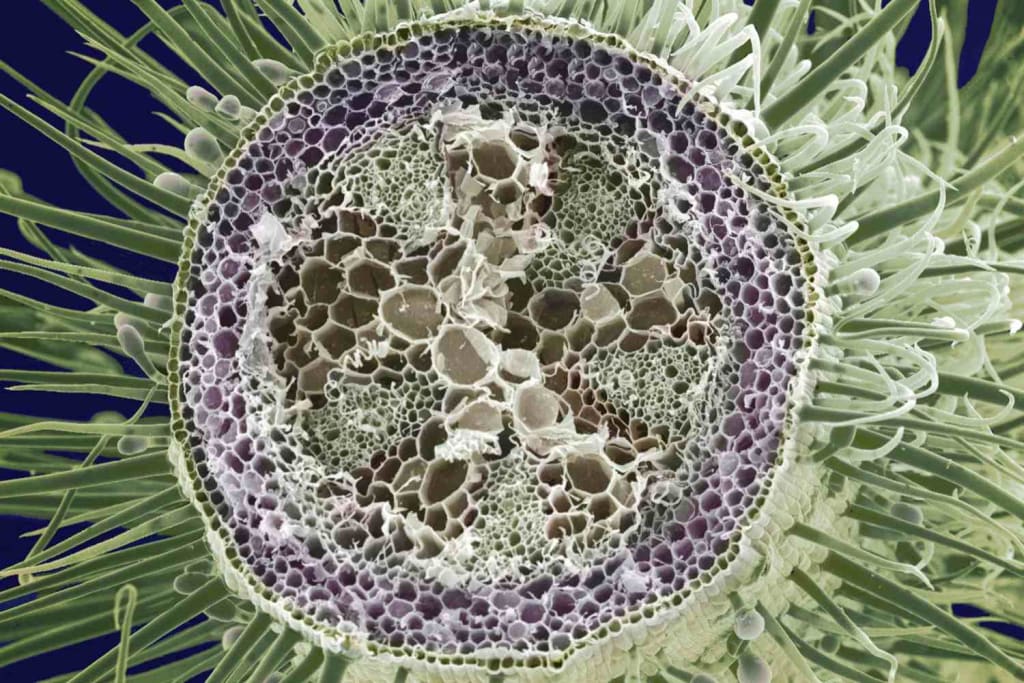Unveiling the Plant's Anatomy
Exploring Tissues and their Functions

Introduction:
In 1924, Dr. Catherine Esau made a remarkable discovery while studying a sugar beet farm in California. She encountered a peculiar virus known as Curly top disease, transmitted by leafhopper insects. Through meticulous examination of the plant's internal structure, Esau uncovered how the virus traveled within the plant. She realized that the virus exploited the same pathway used by the plant's food transport system, specifically the cells responsible for moving sugars produced through photosynthesis. This groundbreaking finding shed light on the significance of understanding healthy plant anatomy to address and improve the health of diseased plants. Today, we delve into the intricate world of plant tissues to gain insight into their functions and the crucial role they play in the life of a plant.
Plant Tissues: Dermal, Vascular, and Ground Tissue:
Just like human bodies, plants possess various tissues, organized groups of cells that share similar structures and functions. These tissues work in harmony to facilitate essential plant processes, similar to how our organs function in unison. In the plant world, the primary tissues are dermal tissue, vascular tissue, and ground tissue.
Dermal Tissue: The Plant's Skin:
Dermal tissue covers the outer surface of the plant and forms the epidermis. To prevent water loss and protect against pathogens, the epidermis is coated with a waxy layer called the cuticle. Pores called stomata, found mainly on the surface of leaves, allow for gas exchange, enabling the intake of carbon dioxide required for photosynthesis. Trichomes, tiny hair-like structures, can also be present on the plant's surface, serving various functions such as protection against herbivores or regulating temperature.
Vascular Tissue: The Plant's Circulatory System:
Vascular tissue acts as the plant's circulatory system, transporting vital substances throughout its body. It consists of two main types of cells: xylem and phloem.
Xylem: Xylem cells are responsible for transporting water and nutrients from the roots to the leaves. These cells undergo a unique process known as programmed cell death, forming hollow pipes that efficiently transport water. Xylem cells provide structural support to the plant and are found in clusters within vascular tissue bundles.
Phloem: Phloem cells transport sugars produced during photosynthesis from the leaves to other parts of the plant. Unlike xylem cells, phloem cells remain alive but lose many of their contents to facilitate sugar transport. They work in conjunction with companion cells that support their metabolic functions. Vascular tissue bundles, comprising both xylem and phloem, form the veins visible in leaves.
Ground Tissue: Everything in Between:
Ground tissue encompasses all tissues that are neither dermal nor vascular. It fills the space between the outer and inner layers of the plant and performs a wide range of functions. Ground tissue consists of three primary cell types:
Parenchyma Cells: These cells are the most abundant in ground tissue and are involved in photosynthesis, storage of starch, and providing structural support. Parenchyma cells are found in leaves and are responsible for the juicy texture of fruits like apples.
Collenchyma Cells: Collenchyma cells provide flexible support to growing plant organs. They have elongated shapes and occur in strings, giving strength to stems and leaves. For example, celery contains collenchyma cells.
Sclerenchyma Cells: Sclerenchyma cells offer structural support to mature plant organs, such as stems. They are often rigid and tough, giving rise to the gritty texture found in pears.
Coordination and Collaboration:
While we have discussed dermal, vascular, and ground tissues separately, it is crucial to remember that these tissues function collectively to enable a plant's growth and survival. They work together within organs such as leaves, stems, and roots, allowing plants to perform vital processes such as photosynthesis, respiration, and nutrient uptake.
Microscopic Exploration of Plant Tissues:
To gain a deeper understanding of plant tissues, microscopic examination of plant organs provides invaluable insights. By taking cross-sections of stems, leaves, and roots and observing them under a microscope, we can witness the intricate arrangement of tissues within these organs.
Stem Cross Section: The cross section of a stem reveals the outer dermal tissue, the ground tissue filling the space between the dermal and vascular tissue, and the vascular bundles containing xylem and phloem cells. This view highlights how the xylem cells transport water from the roots to the leaves, while the phloem cells distribute sugars throughout the plant.
Leaf Cross Section: The cross section of a leaf showcases the major vein running through the center, comprising both xylem and phloem cells. Surrounding the veins is ground tissue, predominantly parenchyma cells responsible for photosynthesis. The presence of stomata on the leaf's underside allows for gas exchange, while the cuticle on the upper surface reduces water loss.
Root Cross Section: In a root cross section, the vascular tissue is located at the center, surrounded by ground tissue. The xylem cells within the vascular tissue efficiently absorb water from the soil, while the phloem cells transport sugars from the leaves to the rest of the plant.
Conclusion:
Studying plant tissues unveils the remarkable complexity and interconnectedness within their anatomy. Dermal tissue acts as the plant's protective skin, while vascular tissue functions as its circulatory system, facilitating the transport of water, nutrients, and sugars. Ground tissue plays a multifaceted role in supporting the plant's structure, performing photosynthesis, and storing reserves. By comprehending the functions and interactions of these tissues, we gain a deeper appreciation of how plants thrive and sustain life on Earth. Moreover, this knowledge allows us to address plant diseases, protect crop yields, and conserve ecosystems reliant on plant diversity. So, let's continue exploring the intricate inner world of plants to further unlock their secrets and promote their well-being.
References:
Esau, C. (1988). A curiosity for plants: A lifetime of observing, exploring, and thinking about plants. University of California Press.





Comments
There are no comments for this story
Be the first to respond and start the conversation.